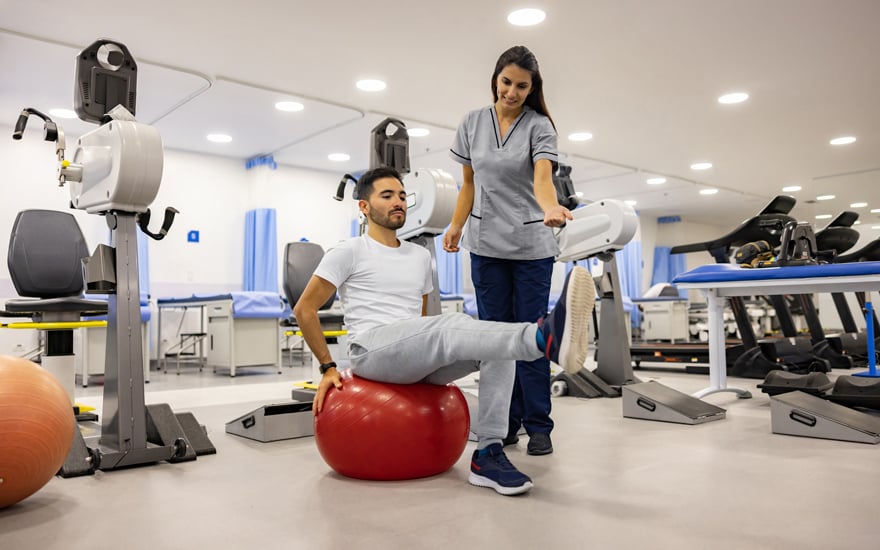Physical Therapy Guide to Meniscal Tear
Meniscal tears are common injuries to the cartilage of the knee. They can affect athletes and nonathletes alike. These tears can happen as a result of a specific movement or develop over time. Your physical therapist can help you heal a meniscal tear and restore your strength and movement. Surgery is often not needed for meniscal tears. If you need surgery, a physical therapist can help you prepare for the procedure and recover afterward.
Physical therapists are movement experts. They improve quality of life through hands-on care, patient education, and prescribed movement. You can contact a physical therapist directly for an evaluation. To find a physical therapist in your area, visit Find a PT.
What Is a Meniscal Tear?
The meniscus is a cartilage disc that cushions your knee. Each knee has two menisci (plural of meniscus). One meniscus is on the inner part of the knee, and the other is on the outer part of the knee. Together, they act to absorb shock and keep the knee joint stable.
There are two categories of meniscal tears: acute or degenerative.
- Acute meniscal tears. These tears mainly occur as a result of twisting or turning quickly on a bent knee, with the foot planted on the ground. This type of injury often produces related injuries, such as an ACL tear.
- Degenerative meniscal tears. This injury occurs over time, due to repeated stress on the knee. Certain jobs and sports that require a lot of squatting put people at greater risk for this type of meniscal tear.
How Does It Feel?
When you tear the meniscus, you might experience:
- A sharp, intense pain in the knee area.
- A "pop" or a tearing sensation in the knee area (acute injury).
- Swelling within the first 24 hours of injury.
- Problems walking or going up or down stairs because of pain or a "catching or locking" sensation in the knee.
Trouble straightening or bending the knee fully.
How Is It Diagnosed?
Your physical therapist will conduct a thorough evaluation. This will include a detailed review of your injury, symptoms, and health history. They also will:
- Measure the range of motion (amount of movement) in your knee.
- Determine which movements and positions increase your symptoms.
- Perform a series of tests to determine if there is any damage to the meniscus.
The results of these tests may indicate the need for further diagnostic tests. If needed, your physical therapist will refer you for additional tests or to an orthopedic surgeon for consultation.
How Can a Physical Therapist Help?

Physical therapists often can help people manage meniscal tears without surgery. A few treatments by a physical therapist can help determine whether you can avoid surgery. Your physical therapist can help you control pain and swelling in the knee area. They will work with you to restore full strength and mobility to your knee.
Physical therapy treatment for a meniscal tear may include:
Manual therapy. Your physical therapist may use manual (hands-on) therapy. This treatment can help to reduce swelling and stiffness and restore muscle function around the knee. Hands-on therapy may include massaging, stretching, or mobilizing the joint.
Icing. Your physical therapist will apply ice packs to the knee to help control any pain and swelling. They also may teach you how to apply ice at home, and how often. Swelling is an important "guide" that can indicate your level of ability and recovery. If you experience an increase in swelling, your physical therapist will modify your treatment program or activity level. They will ensure your safest, most effective recovery.
Compression. Your physical therapist may recommend using compression bandages, stockings, or pumps. These can help reduce or prevent further swelling. They also may use them as part of your regular treatments and teach you how to use them at home.
Neuromuscular electrical stimulation. Your physical therapist may use a treatment called neuromuscular electrical stimulation. NMES uses electrical current to gently stimulate and contract the muscles around your knee. This can help improve muscle strength.
Assistive devices. You may need to use crutches, a cane, or a walker in the short term. Your physical therapist will recommend which walking aide is best for you. They also can teach you how to use it to reduce strain on your knee.
Strengthening exercises. Your physical therapist will design exercises to help you build and keep your strength during recovery. Building strength will help restore full movement to your knee. They also will provide you with a home exercise program specific to your condition. Strengthening the muscles around the knee and throughout the leg helps ease pressure on the healing knee tissue.
Fitness counseling. As you recover, your physical therapist will advise you on ways to improve and maintain your fitness. They will recommend activities that are safe for you to do. They also will help you decide when you are ready to return to full activity.
How Can a Physical Therapist Help Before and After Surgery?
People with more serious meniscal tears, or those who don’t respond to physical therapy, may need surgery. Surgery to remove the torn cartilage (a procedure called a meniscectomy) is usually a simple procedure. It requires physical therapy treatment after surgery to help you restore function and recover. After surgery, and about four months of physical therapy treatment, many people are able to return to their previous activity levels, including sports. However, each person is different. Your physical therapist will design the safest, most effective treatment plan to meet your specific needs and goals.
Meniscus removal. After a simple removal of the torn part of your meniscus, your physical therapy treatment plan will be similar to that for nonsurgical meniscal injuries. Your physical therapist may use ice and compression to control pain and swelling. They will show you how to use these treatments at home. The main focus of your treatment will be on helping you get back your strength and movement. Your treatment plan will include a series of exercises done in the clinic and at home. Your physical therapist also may use hands-on treatment (manual therapy). At first, you likely will need to use crutches or a cane to walk. Your physical therapist will help guide you toward gradually placing weight on your knee to stand or walk. This progression will allow the remaining meniscus and other tissue in the knee joint to adjust to increased pressure.
Meniscus repair. Sometimes your surgeon will be able to repair instead of remove a torn meniscus. Research shows that if a repair is possible, it can reduce the risk of arthritis developing later in life. Physical therapy after a meniscal repair is slower and more extensive than with meniscal removal. This is because the repaired tissue must be protected while it is healing. The type of surgery, the extent of your injury, and your surgeon’s recommendations will determine how quickly you can:
- Put weight on your leg.
- Stop using crutches.
- Return to your previous activities.
After a meniscal repair surgery, your physical therapist will:
- Help you control pain and swelling.
- Guide you through progressive reloading of weight to the knee (i.e., standing and walking). This will allow the cartilage to slowly adjust to increased stress and pressure.
- Help restore your knee and leg range of motion.
- Teach you exercises to help restore your muscle strength.
Return to activity. Whether your torn meniscus recovered on its own or required surgery, your physical therapist will play an important role in helping you return to your previous activities. They will help you learn to walk without favoring the leg and perform activities like going up and down stairs with ease.
Return to work. If you have a physically demanding job or lifestyle, your physical therapist can help you return to these activities. They will help teach you how to properly perform repeated movements in order to put less stress on your knee.
Return to sport. If you are an athlete, you may need a more lengthy course of physical therapy to return to your prior level of activity or competition. Your physical therapist will help you maximize your return to sport and prevent reinjury by working with you to fully restore your:
- Strength.
- Endurance.
- Flexibility.
- Coordination.
Return to sport varies greatly from person to person. It depends on the:
- Extent of your injury.
- Specific surgical procedure.
- Surgeon’s recommendations.
- Type of sport in which you take part.
Your physical therapist will consider these factors when designing and adjusting your treatment program. They also will work closely with your surgeon to determine when it is safe for you to return to sports and other activities.
Can This Injury or Condition Be Prevented?
There is little research at this time to support bracing to prevent meniscal injuries. However, you can make choices to help improve your overall fitness and keep your knees as strong and as healthy as possible. Some ways that can help you keep your knees strong include:
- Doing regular exercises to help strengthen the muscles that support your knees.
- Staying physically active to prepare your body for the demands of a sport or strenuous activity.
- Avoiding twisting or turning quickly while your foot is planted on the ground. This will help prevent stress to the knee that can cause a meniscal tear.
If you already have knee problems, your physical therapist can help you develop a fitness program that takes your knees into account. Some exercises are better than others for those with a history of knee pain. Your physical therapist will modify exercises to fit your specific needs.
What Kind of Physical Therapist Do I Need?
All physical therapists are prepared through education and experience to treat a variety of conditions or injuries. You may want to consider:
- A physical therapist who is experienced in treating people with orthopedic (musculoskeletal) problems or sports injuries.
- A physical therapist who is a board-certified orthopaedic clinical specialist or who completed a residency or fellowship in orthopedic or sports physical therapy. This physical therapist has advanced knowledge, experience, and skills that may apply to your condition.
You can find physical therapists in your area with these credentials and clinical expertise on Find a PT, a tool built by the American Physical Therapy Association.
General tips when you're looking for a physical therapist:
- Get recommendations from family, friends, or other health care providers.
- When you contact a physical therapy clinic for an appointment, ask about the physical therapist's experience in helping people with a meniscal tear.
- Be prepared to describe your symptoms in as much detail as possible, and say what makes your symptoms better or worse.
The American Physical Therapy Association believes that consumers should have access to information to help them make informed decisions and prepare them for their visit with a health care provider.
The following resources offer some of the best scientific evidence related to physical therapy treatment for meniscal tears. They report recent research and provide information on the standards of practice both in the United States and internationally. They link to a PubMed* abstract (which also may offer free access to the full text) or other resources. You can read them or print out a copy to bring with you to your health care provider.
Fernández-Matías R, García-Pérez F, Gavín-González C, et al. Effectiveness of exercise versus arthroscopic partial meniscectomy plus exercise in the management of degenerative meniscal tears at 5-year follow-up: a systematic review and meta-analysis. Arch Orthop Trauma Surg. 2022 August 22 (published online ahead of print). Article Summary in PubMed.
McHugh CG, Opare-Addo MB, Collins JE, et al. Treatment of the syndrome of knee pain and meniscal tear in middle-aged and older persons: a narrative review. Osteoarthr Cartil Open. 2022;4(3):100282. Article Summary in PubMed.
Noorduyn JC, van de Graaf VA, Willigenburg NW, et al. Effect of physical therapy vs arthroscopic partial meniscectomy in people with degenerative meniscal tears: five-year follow-up of the ESCAPE randomized clinical trial. JAMA Netw Open. 2022;5(7):e2220394. Article Summary in PubMed.
van der Graaff SJ, Eijgenraam SM, Meuffels DE, et al. Arthroscopic partial meniscectomy versus physical therapy for traumatic meniscal tears in a young study population: a randomised controlled trial. Br J Sports Med. 2022;56(15):870–876. Article Summary in PubMed.
Lee SH, Lee OS, Kim ST, Lee YS. Revisiting arthroscopic partial meniscectomy for degenerative tears in knees with mild or no osteoarthritis: a systematic review and meta-analysis of randomized controlled trials. Clin J Sport Med. 2020;30(3):195–202. Article Summary in PubMed.
Sherman SL, DiPaolo ZJ, Ray TE, et al. Meniscus injuries: a review of rehabilitation and return to play. Clin Sports Med. 2020;39(1):165–183. Article Summary in PubMed.
Logerstedt DS, Scalzitti DA, Bennell KL, et al. Knee pain and mobility impairments: meniscal and articular cartilage lesions revision 2018. J Orthop Sports Phys Ther. 2018;48(2):A1–A50. Article Summary in PubMed.
Hare KB, Lohmander LS, Kise NJ, et al. Middle-aged patients with an MRI-verified medial meniscal tear report symptoms commonly associated with knee osteoarthritis. Acta Orthop. 2017;88(6):664–669. Article Summary in PubMed.
Heckmann TP, Barber-Westin SD, Noyes FR. Meniscal repair and transplantation: indications, techniques, rehabilitation, and clinical outcome. J Orthop Sports Phys Ther. 2006;36(10):795–814. Article Summary in PubMed.
Lowery DJ, Farley TD, Wing DW, et al. A clinical composite score accurately detects meniscal pathology. Arthroscopy. 2006;22(11):1174–1179. Article Summary in PubMed.
*PubMed is a free online resource developed by the National Center for Biotechnology Information. PubMed contains millions of citations to biomedical literature, including citations in the National Library of Medicine’s MEDLINE database.
Expert Review:
Feb 23, 2023
Revised:
May 9, 2023
Content Type: Guide
Meniscal Tear
PT, DPT, MS
Erin Holt
PT, DPT
James E. Zachazeweski
PT, DPT, board-certified clinical specialist in sports physical therapy, on behalf of the American Academy of Sports Physical Physical Therapy
You Might Also Like...
Patient Stories
Professor Goes From Physical Therapy Skeptic to BelieverJul 29, 2021
"I wouldn't hesitate to seek out the assistance of skilled physical therapists in the future."
Patient Stories
Triathlete Who Is Legally Blind Relies on Physical Therapists to Keep MovingJul 23, 2021
"The physical therapist and the physical therapy treatment are the only things that have allowed me to be where I am right now."
Did You Know?
Arthroscopy Not Recommended for Degenerative Knee DiseaseAug 29, 2017
A recent study concluded that arthroscopic surgery for degenerative knee disease (including arthritis and meniscal tears) did not result in lasting pain


